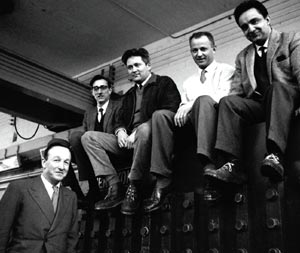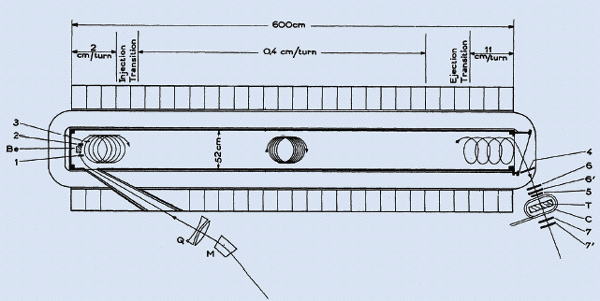Chris Jones looks back 45 years to when the arrival of a special magnet at CERN began a long dynasty of g-2 experiments that continued at the laboratory for more than 20 years.

This is the simple story of a magnet, albeit a rather special one, which is celebrating its 45th birthday at CERN this year. It is somewhat surprising that it has survived! It lives out a peaceful retirement at the far end of the site, as befits a senior magnet that can claim to have fathered a family sharing the same aim.
The magnet came to CERN as the heart of the first g-2 experiment, the aim of which was to measure accurately the anomalous magnetic moment, or g-factor, of the muon. This experiment was one of CERN’s outstanding contributions to physics, and for many years was unique to the laboratory. Indeed, three generations of the experiment were performed at CERN during its first 25 years.
At present the best determined value of g for the muon is 2.0011659208 (Bennett et al. 2004). Clearly one is trying to measure to very high precision a number that is very close to two. The elegance of the experimental method, which uses physics to measure g-2 directly through a determination of frequency (hence facilitating precision measurement), has attracted experimentalists for more than five decades. In addition this parameter has, with considerable reason, fascinated theorists over the same period and continues to be a rare target where experiment can test theory to the limit of its precision.
The purchase of this first 6 m-long g-2 magnet was agreed by the CERN Finance Committee on 14 November 1959, and the magnet was delivered by Oerlikon of Switzerland on 11 July 1960 (figure 1). But was this really the first g-2 magnet, and why was it of this form?
Before 1960 there were a number of experiments, and a list of outstanding names, each of which contributed their piece of the puzzle. If one piece is to be singled out, it must be the establishment of parity non-conservation in the pion-muon-electron decay sequence by the experiments of Richard Garwin, Leon Lederman and Marcel Weinrich, and by Jerome Friedman and Valentine Telegdi (Garwin et al. 1957; Friedman and Telegdi 1957). In this way, two fundamental, enabling “gifts of nature” became known: the muons are born 100% polarized in the pion rest frame, and the asymmetry of the angular distribution of the electrons emitted in their subsequent decay enables the polarization of the muon sample to be traced as a function of time (Combley et al. 1981).
The stage was thus set for a direct attack on the magnetic-moment anomaly for muons. The team that assembled was more than noteworthy with, in alphabetic order, Georges Charpak, Francis Farley, Richard Garwin, Theo Muller, Johannes Sens and Antonino Zichichi (figure 2). The design of their experiment fully exploited the initial muon polarization and final decay electron asymmetry through the idea that it should be possible to store muons in a conventional bending magnet that provided an approximately uniform vertical field.

The magnet was installed in a longitudinally polarized beam of positive muons, arising from the decay of pions produced by CERN’s 600 MeV synchrocyclotron (SC). The magnetic field was arranged in such a way that the muons, introduced at one end of the magnet, were stored in circular orbits that moved along the magnet until they exited at the far end into the analyser; there they decayed, emitting an electron as a sign of polarization. Figure 3 shows how these orbits were suitably spaced (2 cm/turn) for capture upon entry to the magnet; then bunched closely together (0.4 cm/turn) in the centre for maximum storage times; and lastly spread out (11 cm/turn) at the end to eject the muons into the analyser. Some clever work was needed to add carefully calculated shims in order to create the very special magnetic field. Figure 4 illustrates the work of shimming the magnet and preparation in the halls of the SC.

In the subsequent experiment much thought and care went into reducing systematic errors, with a result of g = 2.001165±5 sent for publication only six months after the magnet was delivered (Charpak et al. 1961). The result agreed rather well with the theoretical value current at the time, g = 2.001165.

In such a short article there is no intention to make a comprehensive review of g-2 physics or experiments. This has been done exceedingly well by others, notably in the recent review article by Francis Farley and Yannis Semertzidis (Farley and Semertzidis 2004). The two subsequent generations of g-2 experiments at CERN were both real storage rings and allowed for higher muon energies and longer lifetimes. They permitted measurements of g-2 over many more frequency cycles, which increased the precision considerably.
One name among many in these two generations of experiments is that of Emilio Picasso, who became interested in g-2 as of 1963, when he was at Bristol and Cecil Powell urged him to work with Farley on theoretical calculations of the g-factor. (My own interest in g-2 was also triggered by Powell.) Picasso went on to lead the third-generation experiment and later the construction of a much bigger storage ring, the Large Electron-Positron Collider. The g-2 experiments moved to the US as of 1983 and have continued the battle at Brookhaven. Of the original pioneers at CERN, Farley still continues to be involved.

The first g-2 magnet at CERN – the focus of this article – can still be found at the far end of the Meyrin site. It is partially disassembled, a little battered and those clever shims have disappeared, but fundamentally it still looks the same as in the pictures of 1960. Luckily no over-enthusiastic administrator has seen fit to scrap this monument to CERN history; perhaps there was a wise guardian angel who knew the magnet’s value. The physics principles of the g-2 experiments are of a rare elegance and the essential parts could be explained to visitors on one panel. Is it not time to give a new lease of life to this 45-year-old magnet as the focus of a new historical exhibit at CERN?





